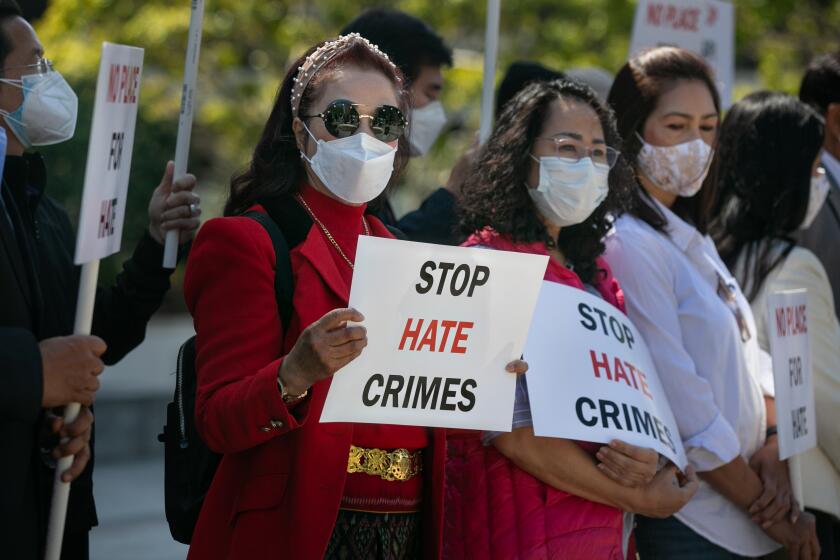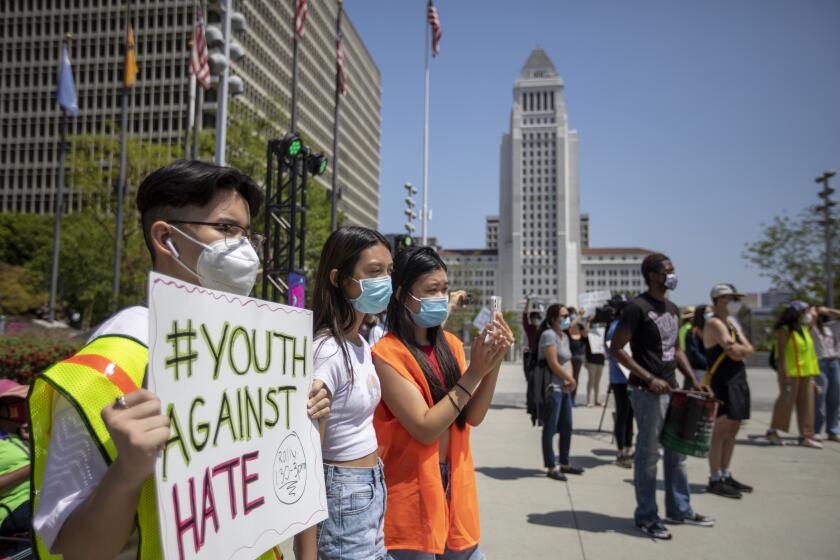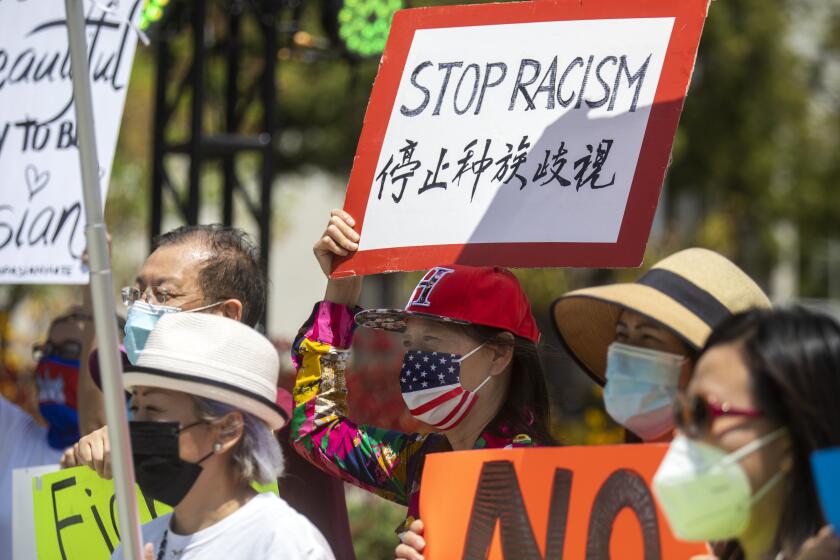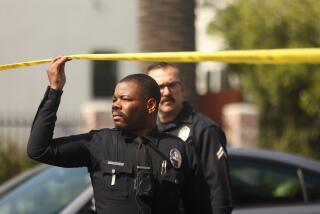‘It’s so pervasive.’ California hate crimes soared 20% in 2022, report shows
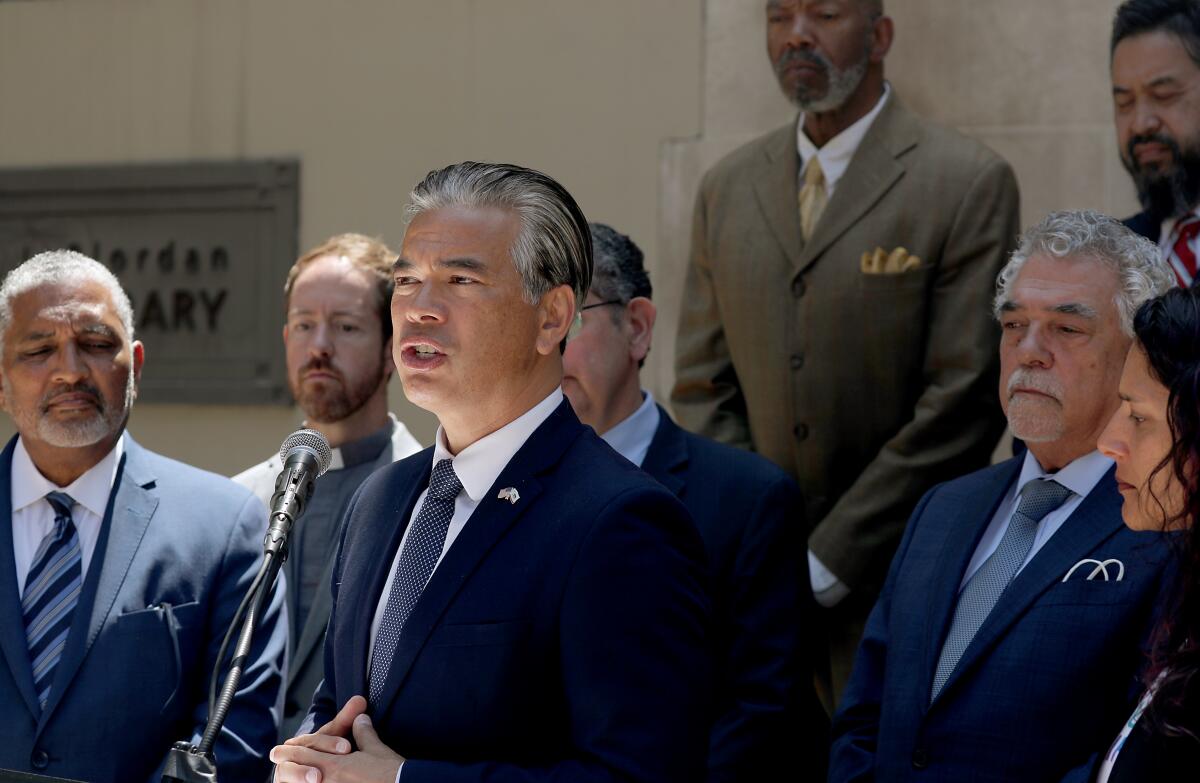
- Share via
Hate crimes soared in California in 2022, with year-over-year rises recorded in crimes targeting virtually every demographic group, according to a report released Tuesday.
All told, there were 2,120 reported hate crimes, a 20.2% jump from the year prior, figures from the California Department of Justice show.
Overall, the number of such events has risen 145.7% since 2013. California’s all-time high in reported hate crimes was 2,261 in 2001.
State Atty. Gen. Rob Bonta attributed the rising numbers to what he characterized as an encirclement of hate.
“Hate-filled rhetoric fills our social media feeds and dominates the news cycles,” he said during a news conference in front of the Los Angeles Central Library on Tuesday. “It infiltrates our schools and our community gatherings. It seems to be at so many places; it’s so pervasive.”
A major departure from the top-line trend was the number of anti-Asian hate crimes — which have soared in recent years, partly due to racially motivated attacks related to the COVID-19 pandemic, but declined sharply from 2021 to 2022.
But that was one of only a few silver linings presented by Bonta, who implored those interpreting the statistics to “remember the contrast since 2020” in anti-Asian hate crimes.
Since before pandemic lockdowns and closures hit California, racism and violence have been targeted at people of Asian descent here, around the U.S. and beyond.
Nearly 1,300 crimes reported in 2022 were suspected to be motivated by bias against someone’s race, ethnicity or national origin. Roughly half of those, 652, were directed at Black residents — a 27.1% increase from the year before.
“The statistics on the numbers for African Americans really set me back,” said Robert Sausedo, president and chief executive of the Leimert Park-based Community Build Inc., which offers education, training and employment placement assistance.
Hate crimes targeting members of the Black community have increased rapidly since the onset of the COVID-19 pandemic. There were 243 anti-Black hate crimes in 2019.
Unlike other groups, Sausedo said, there are “no more African American communities” to give refuge to residents, but “just communities where African Americans live.”
Anti-Asian hate crimes fell to 140 in 2022, a decrease of 43.3% and the first year-over-year drop since 2018.
The number of hate crimes in California rose for the third year in a row, according to an annual report from the state Department of Justice.
Last year’s figure is still significantly elevated from the historic lows of the mid-2010s. There were 19 anti-Asian events in 2014 and 2015 and 35 or fewer in all but one year between 2013 and 2018.
When asked what worked in lowering anti-Asian hate crimes, Bonta did not provide an answer but rather stressed that the numbers still needed to improve.
“We’re still at very high numbers and we’d like to get them down,” said Bonta, the state’s first Filipino American attorney general. “We acknowledged that we’re still in a very high area and there’s more work to do.”
Paul Estuar, litigation director of the civil rights group Asian Americans Advancing Justice Southern California, said attacks against the community ranged from hate-filled phrases to punches.
He pointed to the assault of an Asian woman on the Metro A Line in May and a Republican congressman in February publicly questioning the “loyalty” of Rep. Judy Chu (D-Monterey Park), the first Chinese American woman elected to Congress.
“Although reports of anti-Asian hate crimes went down in 2022 from its peak in 2021, we know incidents are still occurring,” Estuar said.
California is officially launching a hotline this week for people to report acts of hate and bias, as the state grapples with a rise in reported hate crimes.
Anti-Latino hate crimes rose 6.6%, to 210, according to the report. Anti-white crimes increased 24.1% to 103.
The Jewish community suffered the bulk of anti-religious hate crimes in 2022 — accounting for 189 out of the 303 reported. That was a 24.3% jump from the previous year. Since 2017, there have been at least 100 hate crimes committed against Jews annually.
“California’s Jewish community did not have to wait till the report was released to experience that increase of hatred directed at us this past year with our own eyes and ears,” said Senior Rabbi Ken Chasen of Leo Baeck Temple in Bel-Air.
Chasen noted the antisemitic banner that hung over the 405 Freeway in October and fliers left at the “homes of congregants” in April 2022, which blamed Jews for Russia’s war against Ukraine.
No other single religious group suffered more than 25 reported hate crimes last year, according to the report.
L.A. County documented 786 hate crime victims in 2021 — the most since 2002. Blacks, Latinos, Jews and LGBTQ people were among the most-targeted groups.
Gay men were the target of the bulk of the 391 reported hate crimes motivated by sexual orientation, accounting for 271 — a 28.4% increase from 2021.
Another 59 hate crimes were reported against transgender people, a 55% increase.
Los Angeles County, the nation’s most populous, recorded the highest number of hate crimes — 857, including 609 in the city of Los Angeles. There were 110 hate crimes reported in Orange County, 105 in San Diego County, 41 in Riverside County, 33 in San Bernardino County, 24 in Ventura County and 17 in Santa Barbara County.
The figures released Tuesday were gathered from local law enforcement agencies that are obligated to report hate crimes to the Department of Justice.
Bonta said he was “fairly confident” those agencies were diligent in their reporting. He did, however, send out guidance regarding the statutory definition of hate crimes and offenses that can fall under that umbrella.
“Our data shows us that law enforcement, over 50% of the time, failed to identify and investigate a hate crime as what it is — a hate crime,” Bonta said. “So, we provided guidance.”
More to Read
Sign up for Essential California
The most important California stories and recommendations in your inbox every morning.
You may occasionally receive promotional content from the Los Angeles Times.
